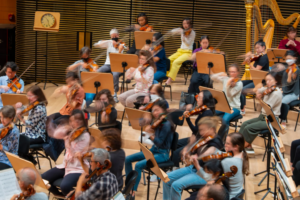Sea Change: The Women of the New York Philharmonic Now Outnumber the Men

When the New York Philharmonic moved to Lincoln Center in 1962, its new hall had no women’s dressing rooms. That’s because there were no women in the orchestra.
But this fall, as the Philharmonic opens its newly renovated home, David Geffen Hall, its players have returned not only to more equitable facilities backstage, but to a milestone onstage: For the first time in its 180-year history, the women in the Philharmonic outnumber the men, 45 to 44.
“It’s a sea change,” said Cynthia Phelps, the principal viola, who joined the orchestra in 1992. “This has been a hard-won, long battle, and it continues to be.”
The orchestra’s new female majority could prove fleeting — it currently has 16 player vacancies to fill, in part because auditions were put on hold during the pandemic — but it still represents a profound shift for an ensemble that had only five women at the beginning of the 1970s. That was the decade it began holding blind auditions, with musicians trying out by playing behind screens.
The pipeline now teems with female candidates: At the Philharmonic, 10 of the 12 most recent hires have been women.
“This certainly shows tremendous strides,” said Deborah Borda, the Philharmonic’s president and chief executive and a pioneer in the field of orchestral management. “Women are winning these positions fair and square.”
“All we seek is equity,” she said, “because society is 50-50.”
Women now make up roughly half of orchestra players nationwide, but they are still substantially outnumbered by men in most elite ensembles, including in Boston, Philadelphia and Los Angeles.
The Philharmonic still falls short by several measures. Women hold only about a third of its leadership positions, including its principal positions and assistant or associate principals, which are the best-paid positions for players. The orchestra has never had a female music director. Some sections remain noticeably divided by gender: 27 of its 30 violinists are now women, for example, while the percussion section is made up entirely of men. There is still a glaring lack of Black and Latino members.
Still, many artists hailed the new prevalence of women in the Philharmonic as a significant development. Symphony orchestras were long seen as the dominion of men. And turnover is generally extremely slow at leading ensembles like the Philharmonic, whose players are tenured and can remain in their posts for many years. Meaningful demographic change can take decades.
“It’s more of a family now,” said Sherry Sylar, associate principal oboe, who joined the orchestra in 1984. “There are moms and pops both.”